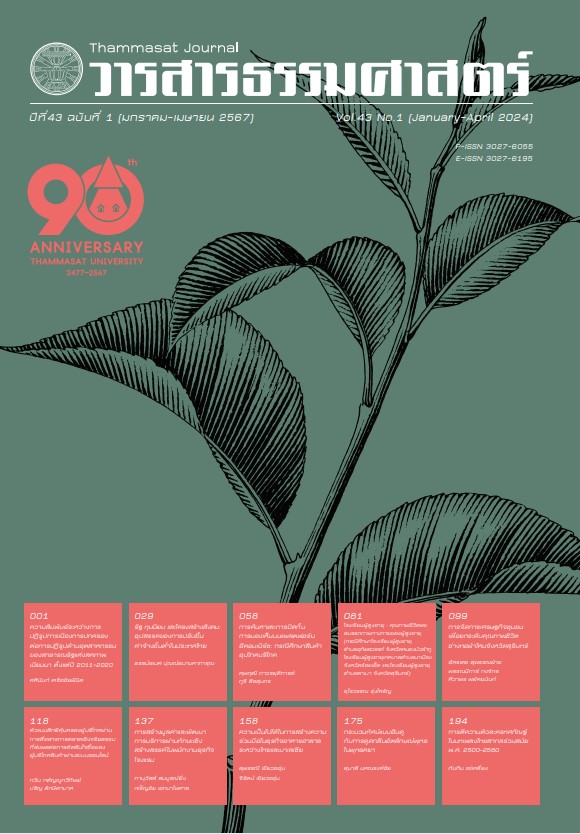Elderly Schools: The Quality of Life and Physical Fitness of the Elderly in Northeast Thailand (A Case Study of Elderly Schools in Uthai Sawan Sub-district, Nong Bua Lamphu Province, Na Mueang Sub-district Municipality, Roi Et Province, and Tabao Sub-district, Surin Province.)
Main Article Content
Abstract
The objectives of the research were to study conduct comparative study of the level of quality of life and physical fitness among the elderly with different periods of participation in the elderly school. This research used a quantitative approach with the researcher adopting the Thai version of the World Health Organization Quality of Life Assessment (WHOQOL-BREFTHAI) and the Elderly Physical Fitness Assessment from the Department of Physical Education. The sample group consisted of 279 elders who participated in the activities at three specifically selected elderly schools: Uthai Sawan Sub-district Elderly School in Nong Bua Lamphu Province, Na Mueang Sub-district Municipality Elderly School in Roi Et Province, and Tabao Sub-district Elderly School in Surin Province.
The study results showed that the majority of the samples were female (85.3%) with more than one-third aged 70 years and above. Nearly all of them (92%) completed primary education and 68.7% worked as farmers. Their monthly incomes were below 1,000 baht (51%), and more than half relied on elderly pensions as their main source of income Regarding health, 54.55% of the participants had chronic diseases, such as hypertension, diabetes, heart disease, etc., but 41.6% had normal Body Mass Index (BMI). In terms of engagement, more than one-third had participated in elderly school activities for more than 3 years with most regularly attending such activities. In addition, the study found that the elderly had a moderate quality of life and good mental health. However, the assessment results of their physical fitness indicated that most had poor physical fitness. Nonetheless, it was found that the elderly, who attended the schools for 3 years had better quality of life and physical fitness compared to those with shorter attendance periods, with statistical significance at the .05 level.
Article Details
References
กรมกิจการผู้สูงอายุ กระทรวงการพัฒนาสังคมและความมั่นคงของมนุษย์. (2559). หลักสูตรโรงเรียนผู้สูงอายุ. กรุงเทพฯ : กระทรวงการพัฒนาสังคมและความมั่นคงของมนุษย์์.
กรมการแพทย์ กระทรวงสาธารณสุข. (2558). คู่มืือการคัดกรอง/ประเมินผู้สูงอายุ. พิมพ์ครั้งที่ 2. กรุงเทพฯ : สำนักงานกิจการโรงพิมพ์สงเคราะห์องค์การทหารผ่านศึก
กรมพลศึกษา กระทรวงการท่องเที่ยวและกีฬา. (2563). คู่มือการประเมินสมรรถภาพร่างกายผู้สูงอายุด้วยแบบแบบทดสอบและเกณฑ์มาตรฐานสมรรถภาพทางกายของเด็กเยาวชนและประชาชนไทย. กรุงเทพฯ : สำนักวิทยาศาสตร์์การกีฬา กระทรวงการท่องเที่ยวและกีฬา
กรัณฑรัตน์ บุญช่วยธนาสิทธิ์ และมาสริน ศกลปักษ์. (2562). วิเคราะห์์องค์์ประกอบเชิงยืนยันสภาวะพฤฒพลัง ด้านสุขภาพของผู้สูงอายุ. วารสารพยาบาลทหารบก, 21(1), 205-213
กัญญาณัฐ ไฝคำ. (2561). การพัฒนาคุณภาพชีวิตผู้สูงอายุในประเทศไทย. วารสารวิชาการมหาวิทยาลัยกรุงเทพธนบุรี, 7(2), 19-26
งามนิตย์ ราชกิจ และพลอยปารีียา อายะนันท์. (2564). ปัจจััยที่มีความสัมพันธ์์กับความสุข 5 มิิติิของผู้สูงอายุ ในเขตอำเภอเมือง จังหวัดเชียงราย. วารสารจิตเวชวิทยาสาร, 37(1), 1-14
ชวลิต สวัสดิ์ผล. (2563). นโยบายการทำงานและการจ้างงานผู้สูงอายุ: ข้อสังเกตบางประการ. วารสารผู้ตรวจการแผ่นดิน, 13(1), 117-132
ประภาเพ็ญ สุวรรณ และมณีรัตน์ ธีระวิวัฒน์. (2564). จาก “พฤฒพลัง” สู่ “พฤฒสุขภาวะ”. วารสารสุขศึกษา, 44(1), 12-29
ปัณณทัต บนขุนทด. (2564). ปัจจัยที่ผลต่อคุณภาพชีวิตผู้สูงอายุในเขตบ้านหนองโพรง ตำบลอิสาณ อำเภอเมือง จังหวัดบุรีรัมย์. วารสารการแพทย์โรงพยาบาลอุดรธานีี, 29(2), 214-222
ศรีวรรณ ปัญติิ. (2551). คู่มือปฏิบััติการ การตรวจสมรรถภาพทางกายในผู้สูงอายุุ. เชียงใหม่ :มหาวิทยาลัยเชียงใหม่
ศศิพัฒน์ ยอดเพชร, ภาวนา พััฒนศรีี และธนิิกานต์ ศัักดาพร. (2560). การถอดบทเรียนตัวอย่างที่ดีของโรงเรียนและชมรมผู้สูงอายุที่มีกิจกรรมถ่ายทอดความรู้. โครงการสร้างและจัดการความรู้เพื่อพัฒนาระบบรองรับสังคมสูงวัย สำนักงานกองทุนการสร้างเสริมสุขภาพ (สสส.)
สามิตร อ่อนคง. (2563). หลักสูตรพัฒนาคุณภาพชีวิตผู้สูงอายุุในทศวรรษหน้า. วารสารบัณฑิตวิทยาลัยพิชญทรรศน์, 15(2), 169-180
สุพิตร สมาหิโต, อำพร ศรียาภัย, สิริพร ศศิิมณฑลกุล, นันทวัน เทียนแก้ว, สมภิยา สมถวิล, อิษฎี กุฎอินทร์ และอาริสร์ กาญจนศิลานนท์. (2556). เกณฑ์มาตรฐานสมรรถภาพทางกายสำหรับประชาชนไทย อายุุ 19-59 ปีี. กรุงเทพฯ : สถาบันวิจัยและพัฒนาแห่งมหาวิทยาลัยเกษตรศาสตร์
สำนักงานสถิติแห่งชาติ. (2560). ดัชนีพฤฒพลังผู้สูงอายุุไทย (Active Ageing Index of Thai Elderly). สำนักงานสถิติแห่งชาติ กระทรวงดิจิทัลเพื่อเศรษฐกิจและสังคม
อุชุก ด้วงบุตรศรี, ทัศนีย์ สติมานนท์, มณเฑียร สติมานนท์, ชรพล จันทร และปิยยุทธ จิตต์จำนง. (2562). ผลกระทบของสังคมผู้สูงอายุต่อการผลิตในภาคเกษตรและความเหลื่อมล้ำของครัวเรือนเกษตรกรในชนบทของประเทศไทย. รายงานวิจัยฉบับสมบูรณ์. สำนักงานกองทุนสนับสนุนการวิจัย (สกว.)
อัจฉรา ปุราคม. (2558). โครงการส่งเสริมกิจกรรมทางกายเพื่อพัฒนาคุณภาพชีวิตผู้สูงอายุุในประเทศไทย. นครปฐม : สำนักงานกองทุนสนับสนุนการสร้างเสริมสุขภาพ (สสส.) สำนักส่งเสริมวิถีชีวิตสุุขภาวะ
Jones, C.J. & Rikli, R.E. (2002). Measuring functional fitness of older adults. The Journal on Active Ageing. 2, 24-30.
World Health Organization. (2015). World Report on Ageing and Health. Printed in Luxembourg.
World Health Organization. (2019). Healthy Ageing and the Sustainable Development Goals. WHO. https://www.who.int/ageing/sdgs/en/

